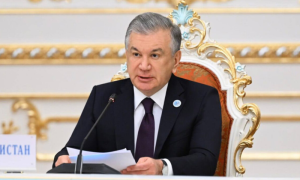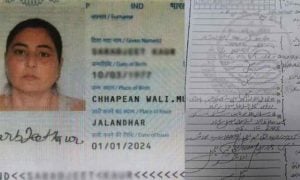Key points
- AUKUS pact being reviewed by Trump administration amid delays
- Australia to receive US and UK-built submarines
- British carrier joins largest-ever Australian military exercise
ISLAMABAD: Britain and Australia have announced plans to sign a long-term cooperation treaty to construct nuclear-powered submarines for the Australian fleet jointly, and have welcomed a review by US President Donald Trump’s administration of the United States’ role in the trilateral defence deal.
The UK’s Defence Secretary John Healey and Foreign Secretary David Lammy met with their Australian counterparts, Deputy Prime Minister and Defence Minister Richard Marles and Foreign Minister Penny Wong, in Sydney on Friday for their annual bilateral discussions, according to AP News.
UK and Australia will sign a 50-year treaty to enhance cooperation on Australia’s nuclear-powered submarine fleet, using U.S. technology.
The deal under the 2021 AUKUS pact, aims to counter Chinese military influence in the Asia-Pacific.
The deal involves delivering at least… pic.twitter.com/dZlHYcVwWz
— Vanguard Intel Group 🛡 (@vanguardintel) July 25, 2025
Marles confirmed that he and Healey would sign a 50-year treaty on Saturday, which will formalise collaboration between the two nations in building a fleet of Australian submarines powered by US nuclear propulsion technology.
“It is as significant a treaty as has been signed between our two countries since federation,” Marles said, referring to the unification of several British colonies to form the Australian government in 1901.
Countering Chinese influence
The AUKUS alliance—formed in 2021 between Australia, the United Kingdom and the United States—is intended to counter growing Chinese military influence in the Indo-Pacific.
The agreement promises Australia at least eight nuclear-powered submarines, including the provision of three to five second-hand US Virginia-class submarines. The UK and Australia are also set to jointly develop a new class of submarine, known as SSN-AUKUS.
We plan together. We train together. We fight together. 🇬🇧🇦🇺
From joint operations in the Indo-Pacific to the AUKUS submarine programme, the defence partnership the UK and Australia share is strengthening global security and driving growth at home. pic.twitter.com/suOzhhi8q0
— Ministry of Defence 🇬🇧 (@DefenceHQ) July 25, 2025
US Defence Secretary Pete Hegseth is currently reviewing the AUKUS agreement, originally signed under President Joe Biden’s administration. Concerns have arisen over whether the United States can deliver the first Virginia-class submarine to Australia by the early 2030s as planned, due to delays in its own submarine production schedule.
When questioned at a press conference about whether the UK and Australia would proceed with the joint submarine project without the US, both Healey and Marles declined to speculate.
Reaffirming commitment
“We welcome the review, as it offers the new US administration an opportunity to reaffirm its commitment to AUKUS—which is precisely what we anticipate,” Healey said.
🇺🇸 is reviewing AUKUS. So is 🇬🇧.
🇦🇺 is the only partner yet to conduct a review.
It’s beyond time for us to have a sensible & sober look at AUKUS and if/how it best serves our national interest.
A transparent review is common sense and long overdue. pic.twitter.com/YOdA3p0Gdc
— David Pocock (@DavidPocock) June 13, 2025
“As for the hypothetical scenario you’ve mentioned, it’s simply not something we’re considering,” he added, addressing the idea of continuing without US involvement.
The Australian government confirmed it had recently made a second payment of $500 million to the United States as part of the AUKUS agreement, following an initial $500 million instalment in February. The total cost of the submarine programme could reach up to $245 billion for Australia.
Australia’s largest-ever military exercise
The diplomatic meetings come as approximately 3,000 British military personnel are participating in Australia’s largest-ever military exercise.
Over 35,000 troops from 19 countries are involved in Exercise Talisman Sabre, a biennial joint military operation that began in 2005 between the US and Australia.
Exercise Talisman Sabre in 🇦🇺 is what collective deterrence looks like. With more than 35,000 personnel from 🇺🇸, 🇯🇵, and 17 other Indo-Pacific and European nations, this multi-domain exercise — the largest since it launched in 2005 — is enhancing our interoperability and… pic.twitter.com/8rtwa9C7Tg
— ジョージ・グラス駐日米国大使 (@USAmbJapan) July 24, 2025
On Sunday, Marles and Healey are scheduled to inspect the British aircraft carrier HMS Prince of Wales at the northern port of Darwin. The carrier is currently taking part in the exercise.
Foreign Secretary David Lammy emphasised that the deployment of the strike group sent a strong message.
“The arrival of our carrier strike group in Darwin demonstrates the UK’s steadfast commitment to this region. It’s a clear message of our resolve to maintain a free and open Indo-Pacific, and a symbol of our unity with our allies,” he said.



























